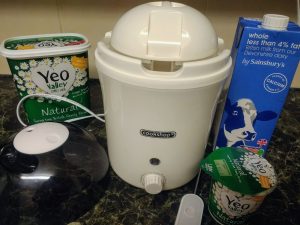
Yogurt as a technique was developed to preserve milk, so it lasts ages in the fridge. I’ve kept it up to two weeks.
I have been specifically aiming for a thick and creamy yogurt with a mild flavour, but you may be less fussy. Your result will be largely governed by the yogurt starter you use, I really like Yeo Valley. I use an electric 1 litre yogurt maker, the simplest way to maintain the right temperature throughout the process, though I’ve discussed other methods previously and list instructions for other options at the bottom of this page. (eg If you pre-warm the milk, you can incubate it in a 1 litre wide-mouth flask, or an Easi-Yo maker.)
The process takes about 8 hours (though you can leave it up to 12 hours), so start it at a time when you can attend to it again after that time. The initial stage is only about 10 min.
1 litre UHT whole milk
2 heaped dessert spoons plain bio yogurt
Put a couple good dollops (heaped dessert-spoons) of your favourite plain, live yogurt into a small jug. Stir in some milk, then a bit more until the yogurt is quite thin.
Pour the milk mixture into the inner container of the yogurt maker. Follow with the rest of the milk, stir, turn on and cover. Leave untouched for 8 hours. (It will be yogurt after around 8 hours, but you can leave it up to 12 hours). When done, turn off, and leave for an hour or two. Then remove inner container (without jostling) and put in fridge to chill. You can make it days ahead when convenient, it will be fine for a couple weeks.
Once set, I then transfer mine to one of the old 1 litre Yeo Valley rectangular tubs I have kept, for better use of fridge space, and also so I can start another batch when the current one is not yet gone. If it isn’t as thick as I’d like, I strain through a couple layers of muslin I keep for the purpose.
NOTES:
- I use UHT milk because fresh milk needs scalding to 82°C then cooling – which is a faff and basically what was already done in the UHT process. I’ve made yogurt both ways and can’t detect any flavour difference. Very handy to be able to keep in stock, and my council takes cartons for recycling. You can also use evaporated milk – a large can plus same again of water. I haven’t tried this for flavour, but I’ve heard several people say this is what they do. You can also use sterilised or flavoured milk, but of course if they come in plastic you haven’t gained anything.
- If you use fresh milk, warm to 82°C as slowly as possible, the effect on the molecules apparently helps it to get thicker. A slow cooker on High does a great job, and takes about 2 hrs. You then need to cool it back down to 43-45°C before mixing with your starter, which I think is another couple hours.
- If you are making yogurt frequently, you can use some of your previous batch to start the next one, at least a few times, or the remainder of the small pot. The worst that can happen is it might not be as thick.
- To thicken yogurt further, strain through 2 layers of muslin cloth for about 20 -30 min. However this removes about 1/4 litre of whey – which means less yogurt!
- You can use the whey to replace milk when baking cakes or scones. It’s great for making cheese sauce!
- If you buy muslin for straining, get .5m and sew a fine hem around the edge. Wash before first use. Fold in half to line a colander, and put the colander over a small bowl or pan to catch the whey. Rinse the cloth well after use, then put through the washer with your whites. If you make yogurt frequently, you might want two cloths.
- Sometimes yogurt seems to go a bit thinner after a week or so, the lower third of the pot. Strain it for a while (15 min or so) and it will get thicker again, and put back into a clean tub.
- No two pots of yogurt seem quite the same from the supermarket, so it’s OK if yours varies a bit too. 😉
Some useful resources I’ve used in my experimentation, included here in case you want to know more:
- Slow cooker bio yogurt
- Ways to get thicker yogurt
- Best temperature for incubation
- More than 6 ways to incubate yogurt…
- Forum discussion of incubation
- How to strain yogurt
- Troubleshooting